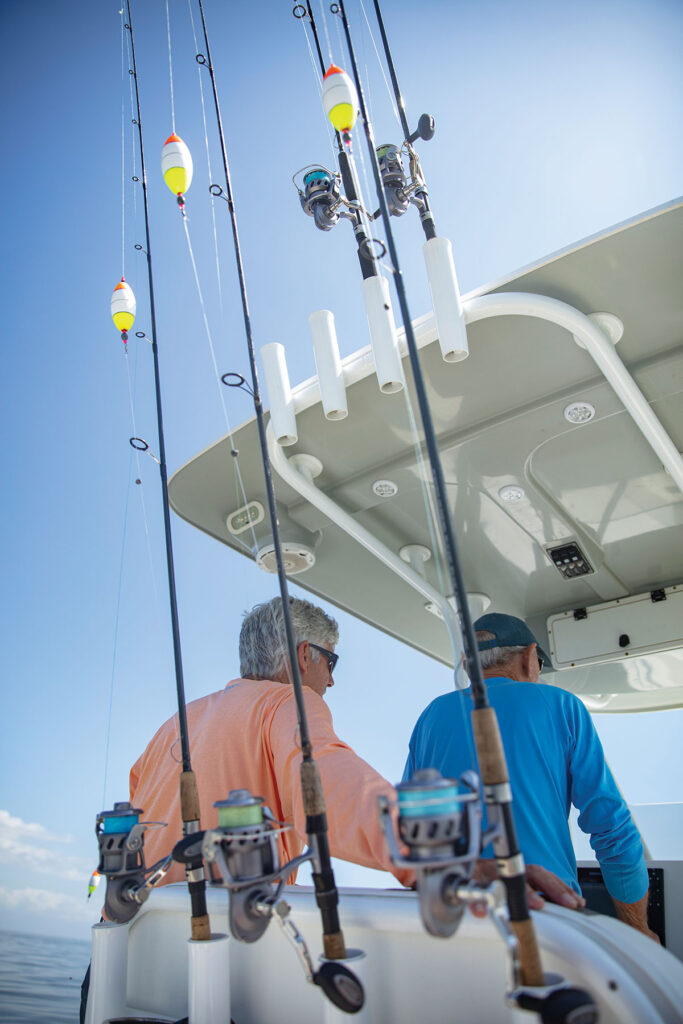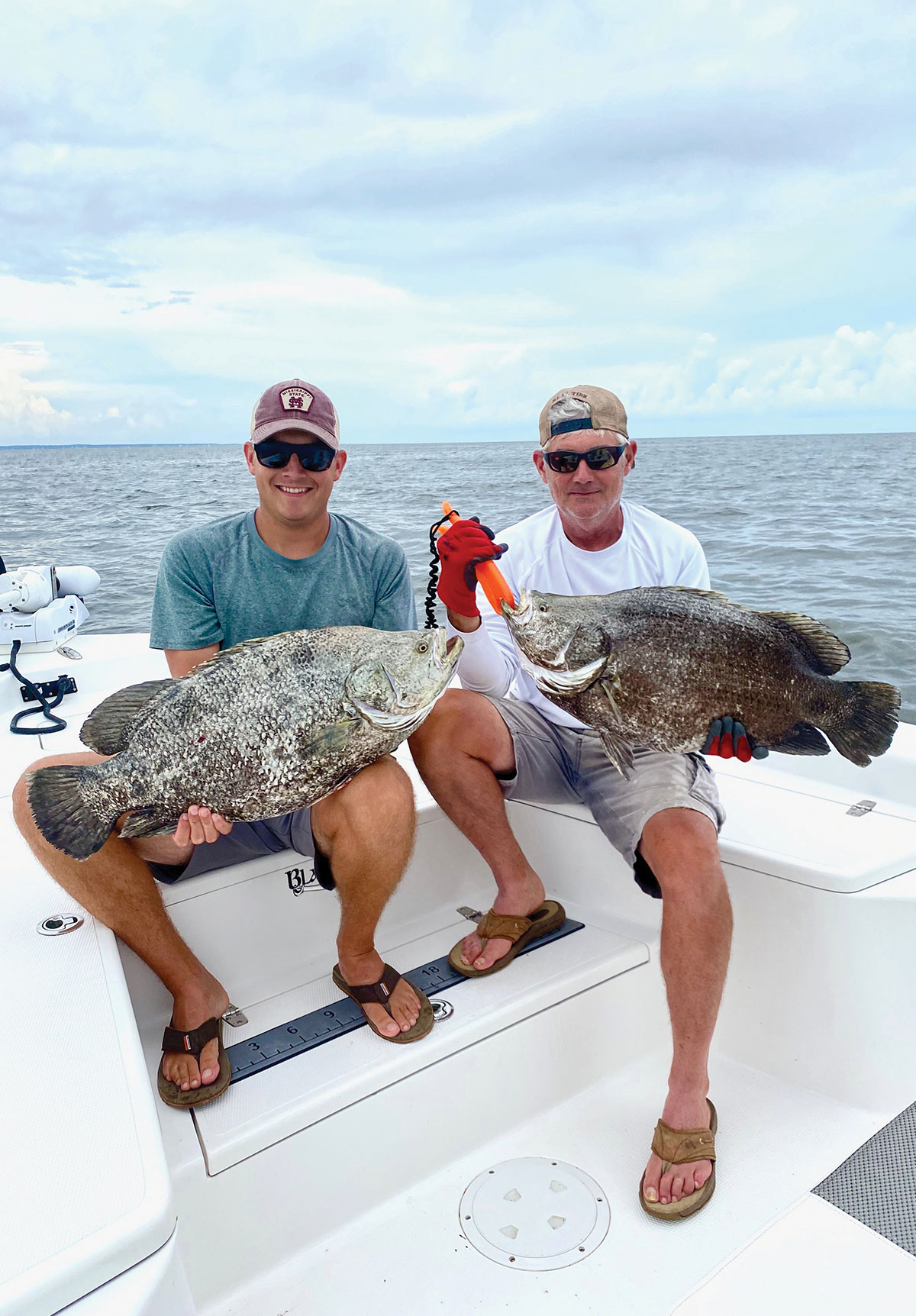
There are two types of anglers around Mobile Bay: those who fish and those who pursue tripletail.
The latter is a community, united by the passion, excitement and skills to reel in a fighter. Because once you catch a tripletail, you are hooked. Hopefully it is, too.
But hope is not enough to land a saltwater warrior with fins sharp enough to cut fishing line like spaghetti noodles. “Catching a tripletail is exciting but requires strategy,” notes Point Clear tripletail fisherman, Dave Stanley. “Bringing one in is a game.” Like most games, it takes practice to play it well.
Stanley’s neighbor is Eric Womble, an avid tripletail fisherman who wets the hook at least weekly when the coveted game fish is in the Bay. “I’m afraid today is not a good day for it,” he remarks while preparing his 25-foot boat for a Mobile Bay Magazine tripletail reconnaissance mission. “The water looks like a chocolate milkshake. Visibility is limited.”
Visibility is key because tripletail is, for many people, a sight-fishing experience. At times, you can actually see the fish floating on its side. Or you can cast at where you think it will be, under or beside a structure either natural, like plant life, or artificial, like a boat piling.

Eric Womble and Kenny Muscat set out in search of the elusive tripletail. 
Womble prefers live shrimp for bait, the bigger the better.
Like all good fishermen who successfully land this fish, Womble knows his quarry. For the rest of us, here is a quick crash course of fish facts — Tripletail 101.
Splotched in brown, black, gray and off-white, with a dental underbite only a mother could love, the tripletail is so named because its dorsal and anal fins are far back on its body. Both fins resemble the fish’s tail in shape and color, giving it the appearance of three tails.
The fish favors saltier water. Heavy rains sometimes dilute Mobile Bay with freshwater, thereby lowering tripletail numbers.
During winter months, tripletail live in the Gulf of Mexico. They come into Mobile Bay around mid-June through September — and so do the anglers who love to catch them. “There is nothing like it in fishing,” Womble says. “Nothing beats the thrill of seeing that cork go down. I was raised around Mobile Bay and have fished all my life. Tripletail is my favorite.”
Lobotes surinamensis, alias blackfish, alias tripletail, is definitely unique. They lie almost motionless, floating underwater on their sides and under anything that provides shade. They are often mistaken for wayward kitchen garbage bags. In their juvenile stage, tripletail blend with their surroundings and can look like floating leaves.
It is a solitary creature that does not school. It typically grows to about 10 to 20-plus pounds and about 2 to 3 feet long in the Bay. It waits very still for prey to swim by and pounces. It does the same with bait — and with a vengeance.
Tripletail are usually laid-back unless provoked by a hook, which they take as a personal insult, instantly shifting to “How dare you!” mode.
Womble adds, “They are unpredictable. You never know if one will take the bait. If it does, you are in for the fight of a lifetime.”
The outraged fish grabs the hook and takes off like a dart. “It will try to wrap the line around a piling or any other structure,” Womble adds. “They fight all the way. You must prevent it from getting to a structure and tangling the line. Act fast. Get it into open water.”
A good boat operator is a valuable asset. “Not just good,” Stanley adds. “The boat driver must be great and someone who knows tripletail behavior and can react to it — fast.”
One such person is Fairhope’s Kenny Muscat. “Everybody helps land one,” says Muscat, today’s boat operator. “If we spot one, I can’t get us too close,” he adds. “It will spook the fish, causing it to sound (go down deep) or swim away. But if you don’t get close enough, you can’t land the bait just right.”
Womble agrees, and adds, “Tripletail are intelligent, smarter than most other fish. When it wraps your line around a submerged structure, it knows exactly what it’s doing.” The key is, don’t let it do that.

“When we see the fish attempting to swim to pilings or other structures, I immediately back the boat up and try to get the fish into open water,” Muscat continues. That’s the time to reel it in, but even then, there are no guarantees you will.
Those who have experienced the battle share a pro tip: A tripletail is not caught until it is — meaning, until it’s in the boat, don’t buy the tartar sauce.
What minutes earlier was an underwater, lethargic sloth with gills is a rage-filled fighting machine when hooked. “Tripletail can battle the line for 30 minutes or more while you’re trying to reel it,” Womble says. It can break free at any time.
He speaks from personal experience.
“I was fishing around a structure with Dave Stanley when I saw it,” Womble recalls about last year’s event and the one that got away. The kitchen garbage bag description was inadequate. “We thought it was a leaf bag,” Womble notes. It was not.
They tossed line out to it. Nothing. Tried again. Nothing. Tried again. BOOM!
“It hit and hit hard!” Womble says. “That fish skimmed across the water for 40 or 50 yards and leaped from the Bay. The biggest tripletail I have caught was 26-and-a-half pounds and 36 inches long. This one was significantly larger, the biggest tripletail I think I had ever seen.”
Plunging back in the water, the scaly rascal skimmed back to where it originated. “I put pressure on the line to keep it on our side of the structure and got it where it needed to be,” the fisherman continues. “It leapt out of the water again and dived back below.” Without warning, the line went slack, as did Womble’s heart.
“I still don’t know what happened,” he shakes his head. “We saw it, we hooked it, we fought it, but it got away.”
For many, the challenge presented in landing a tripletail is what makes it so enjoyable. “You will lose two out of three when starting out as a beginner,” notes Dr. Tim Stewart, a Fairhope veterinarian. “Tripletail fishing requires being in the exact right place at the right time. You must present the bait in just the right way, tempting the fish to take it.” Sometimes it will. Sometimes it won’t.
“This fish is smart,” Stewart adds, “and it is cautious. But it is a great feeling landing your first one, using your techniques on your boat and bringing it in. The best tripletail you catch is the one you finally reel in by yourself. You realize, ‘I did this. I got this.’”
All agree the best way to gain the skills needed to yank a tripletail from saltwater is through the teaching of others. “I learned from Eric,” Stewart notes. He laughs, “If you remember the old TV show ‘Kung Fu,’ I compare Eric to the master, and I am the grasshopper.
“Everybody develops their own techniques,” Stewart says. “Their methods are what work for them. But all techniques include very precise positioning of the boat and the correct way to present bait. I think what makes it special is everybody feels their technique is the correct technique, and if it works for them, it is.”

Eric Womble and his son Matt show off their tripletail haul in Mobile Bay, summer 2020. 
Matt Womble displays his behemoth catch, summer 2020. A perfect cast shows the float just kissing the edge of the piling as it drifts past in hopes of finding a fish.
Details, Details
Although dead shrimp works, Womble prefers live shrimp as bait; the bigger the crustacean, the better.
Use 30 to 40-pound leader line as Bay fish reside near structures and will often try to wrap your line around that structure. If that happens, the party’s over.
A heavy lead is needed to pull the fish away from the structure and into open water.
Presentation is critical. Never cast your bait directly at the fish or its structure. Tripletail know what you are doing, and if it suspects you, it will dart to the bottom of the Bay. Instead, throw 20 feet up current or up wind and let the bait float to the fish.
Look for floating logs, debris or weeds. Trees can be a tripletail bonanza. Womble once pulled almost two dozen fish from a floating tree over a span of two or three weeks.
It is better to fish on rising or falling tides with little to no wind. It is easier to fish the moving tides without wind complicating the process.
Handle the fish with caution. The preopercule (bony plate just forward of the gill cover opening) is serrated and sharp. The dorsal spines are stiff and sharply pointed. “Don’t stick your fingers in its gill plate,” Stanley warns. “It can cut your hand slap off.”
The rewards and pure fun of catching a tripletail continue onshore with additional benefits. Tripletail is perhaps the best-kept seafood secret on the Gulf Coast. “Sauteed and lightly battered, it is simply marvelous,” Womble notes.
Regardless of their techniques, abilities and experience in fishing tripletail, the fisherman all share a concern for conservation. “Tripletail fishing was hardly talked about 10 years ago,” says Stewart. “Today, it seems like everybody is doing it or wants to.”
Alabama law allows a three tripletail per person limit, 18 pounds and up. Womble and Stanley believe the rule is too lenient and should be changed. “I think it should be one fish per person, not three, and 20 pounds, not 18,” Womble notes. Stanley agrees in a telephone interview: “You can eat a lot of meals from an 18-pound tripletail.”
“Two years ago, tripletail were plentiful. It was harder to catch last year,” Womble warns. “Seems like the population was thinner by my experience. More people are fishing. More boats are out there. We have to be careful not to deplete the numbers. If we’re not careful, we are going to overfish this thing.”
He wants his 2-year-old grandson to enjoy the sport as much as he and his family have. “There is nothing like watching our next generation cast at what looks like a garbage bag and catch their first tripletail,” Womble says. “I want the fish to be around for them to catch.”
But on this day, Womble and Muscat prepare their boat for another adventure. As Stanley said, catching tripletail is more than fishing, it is a game. Perhaps today’s trip will once again challenge the Goliath that got away last year.





